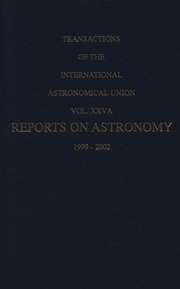No CrossRef data available.
Article contents
New Student Laboratory Work about Pulsational Phenomena in Astronomy
Published online by Cambridge University Press: 25 April 2016
Extract
The pulsation phenomenon is inherent to most types of object and it plays a great role at certain stages in the evolution of objects in the universe. That is why students must study this phenomenon in the framework of laboratory hours. Often the study of these phenomena is reduced to an analysis of some differential equations with variable coefficients. A class of these equations is connected with the stability problem of the oscillations of self-gravitating systems (S. Nuritdinov, Sov. Astron., 1985, 29, 293). In order to carry out this laboratory work every student is required to compose a computer program using the periodical solution stability method and the parameter resonance theory. The program will find the critical amplitude of the pulsation and some dependences between physical parameters.
- Type
- Section 3: Initiatives in Astronomy Education
- Information
- Copyright
- Copyright © Astronomical Society of Pacific 2001


